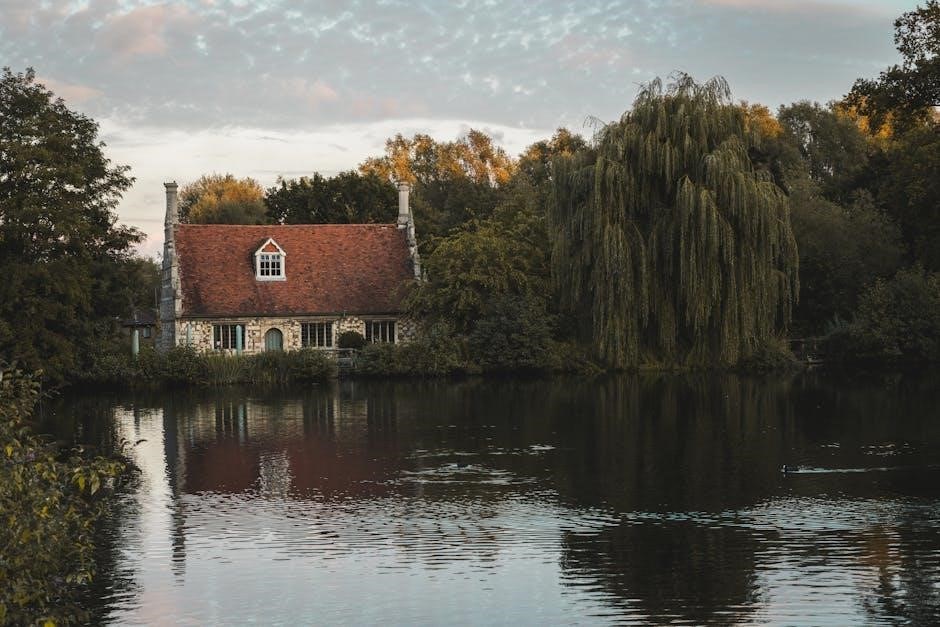
-
By:
- ruby
- No comment
the fall of the house of usher study guide
Title: The Fall of the House of Usher Study Guide
The Fall of the House of Usher Study Guide provides a comprehensive analysis of themes, symbols, and character dynamics, offering insights into Poe’s haunting tale and its significance in Gothic literature․
Edgar Allan Poe, a master of Gothic horror, crafted The Fall of the House of Usher in 1839, a haunting tale of madness, fear, and supernatural mystery․
2․1․ Biographical Background of Edgar Allan Poe
Edgar Allan Poe (1809–1849) was an American writer, poet, and critic, known for his pioneering work in detective fiction and Gothic horror․ Orphaned at three, Poe was raised by foster parents in Virginia․ His tumultuous life included military service, academic expulsion, and a struggling writing career, all while battling personal tragedies and addiction․ His dark, atmospheric style reflects his troubled yet brilliant mind․
2․2․ Historical Context of the Story
The Fall of the House of Usher was published in 1839, a time of rising interest in Gothic fiction and psychological exploration․ The story reflects 19th-century anxieties about mental illness, family decline, and supernatural phenomena․ Its themes of isolation and decay resonated with the era’s fascination with the darker aspects of human nature and the crumbling of traditional societal structures․
2․3․ Significance of the Story in Gothic Literature
The Fall of the House of Usher stands as a masterpiece of Gothic literature, blending horror, psychological complexity, and atmospheric detail․ Its exploration of madness, family curses, and the supernatural influenced countless works in the genre․ The story’s innovative use of symbolism and psychological depth solidified its place as a foundational text in Gothic tradition․
The Fall of the House of Usher follows a narrator visiting his childhood friend Roderick Usher at his crumbling mansion․ Roderick’s mental state deteriorates as mysterious events unfold, culminating in the tragic collapse of the house and the Usher family’s dark legacy․
3․1․ Plot Overview
The Fall of the House of Usher begins with a narrator visiting his childhood friend, Roderick Usher, at his decaying mansion․ Roderick, suffering from mental and physical distress, believes the house is alive and sentient․ His sister, Madeline, falls ill and appears to die, prompting Roderick to entomb her in the house․ Strange occurrences escalate, and during a storm, the house collapses, burying the Usher family and their dark secrets․
3․2․ Key Themes: Madness, Fear, and the Supernatural
Madness is central to the story, as Roderick Usher’s deteriorating mental state drives the plot․ Fear permeates the narrative, from the eerie setting to the characters’ terrifying experiences․ The supernatural is evident in the haunting atmosphere, Madeline’s mysterious illness, and the sentient house, blurring reality and fantasy to create a chilling exploration of psychological and paranormal horrors․
3․3․ Symbolism in the Story: The House, the Family, and the Tarn
The house symbolizes the crumbling Usher family, its decay reflecting their physical and mental deterioration․ The family represents isolation and a cursed lineage, while the tarn, with its dark, mirror-like water, embodies the unknown and the subconscious․ Together, these symbols create a haunting allegory of decline, madness, and the inescapable fate that binds the Ushers to their doomed heritage․

Character Analysis
Roderick Usher, with his fragile mental state, embodies artistic brilliance and psychological turmoil․ Madeline, his ailing sister, symbolizes tragic vulnerability, while the narrator serves as a grounded observer, amplifying the story’s dark mystery and themes of decay and madness․
4․1․ Roderick Usher: His Mental State and Artistic Temperament
Roderick Usher is portrayed as a man of artistic brilliance but plagued by mental instability․ His hypochondria and paranoia intensify as the story progresses, reflecting his fragile psyche․ His belief in a family curse and supernatural forces exacerbates his fear, leading to a downward spiral into madness․ His artistic temperament, while creative, becomes a source of his escalating torment and eventual breakdown․
4․2․ Madeline Usher: Her Illness and Role in the Story
Madeline Usher suffers from catalepsy and a mysterious terminal illness, contributing to the eerie atmosphere․ Her condition worsens the family’s sense of doom and isolation․ Her presence and eventual death deeply affect Roderick, intensifying his mental anguish and fear of the supernatural․ Her role underscores the story’s themes of decay, madness, and the inescapable fate of the Usher family․

4․3․ The Narrator: His Perspective and Role in the Story
The narrator serves as the outsider whose visit to the House of Usher sets the story in motion․ His perspective provides context and heightens the eerie atmosphere, as he describes the unsettling environment and the Usher siblings’ deteriorating states; Though empathetic, his inability to fully grasp the supernatural events underscores the mystery and horror, making him both a participant and an observer in the unfolding tragedy․

Discussion Questions and Themes
Discussion Questions and Themes delve into the psychological depths of the Usher family, exploring the family curse, isolation, fear, and the supernatural, prompting deeper analysis of Poe’s haunting narrative․
5․1․ The Concept of the “Family Curse”
The family curse in The Fall of the House of Usher is a central theme, with Roderick believing it contributes to his family’s decline․ The decaying mansion and Madeline’s illness symbolize this inherited suffering, while the curse’s supernatural elements tie the family’s fate to the crumbling house, reinforcing the inevitability of their doom․
5․2․ The Role of Isolation and Setting
The isolated setting of the Usher mansion creates an eerie atmosphere, emphasizing the characters’ psychological unraveling․ The remote, decaying house and the dark tarn symbolize the family’s disconnection from the outside world, heightening the sense of dread and supernatural mystery․ This isolation amplifies the story’s gothic horror, trapping the characters in their doomed fate․
5․3․ The Psychological Aspects of the Characters
Roderick Usher exhibits extreme anxiety and a belief in a family curse, while Madeline suffers from mysterious physical and mental illnesses․ The narrator’s perspective heightens the eerie atmosphere, as he struggles to understand the unfolding horror․ Their psychological states drive the story’s themes of madness, fear, and the supernatural, intertwining their fates with the crumbling house․

Literary Devices and Style
Poe masterfully employs Gothic horror elements, vivid imagery, and a haunting first-person narrative to create a chilling atmosphere, immersing readers in the story’s eerie and psychological depths․
6․1․ Use of Imagery and Descriptive Language
Poe’s masterful use of imagery and descriptive language creates a haunting atmosphere, drawing readers into the eerie world of the Usher mansion․ The decaying house, with its crumbling walls and dark tarn, serves as a vivid reflection of the characters’ psychological states․ Sensory details, such as the “hideous” inverted house image in the water, amplify the sense of dread and foreboding, immersing readers in the story’s unsettling environment․
6․2․ The First-Person Narrative Technique
The story employs a first-person narrative, creating an intimate and subjective experience․ The narrator’s perspective heightens suspense and mystery, as readers witness events through his limited, often unreliable viewpoint․ This technique isolates the narrator and the Usher family, intensifying the eerie atmosphere while leaving interpretations open to speculation and deepening the psychological complexity of the tale․
6․3․ The Influence of Gothic Architecture on the Story
The decaying, ancient mansion in The Fall of the House of Usher embodies Gothic architecture, with its towering spires, crumbling walls, and mysterious underground chambers․ The house serves as a symbol of the family’s cursed legacy and descent into madness, its eerie, imposing structure mirroring the psychological turmoil of its inhabitants․ This architectural style enhances the story’s haunting atmosphere and foreboding sense of doom․

Study Resources and Guides
Explore comprehensive study resources, including summaries, analyses, and discussion questions, along with quiz topics and essay prompts to deepen your understanding of the story․
7․1․ Recommended Study Materials and Summaries
Recommended study materials include SparkNotes, Course Hero, and LitCharts, offering detailed summaries, character analyses, and theme explanations․ eNotes provides chapter-by-chapter breakdowns, while Shmoop offers engaging video and audio guides․ For a deeper dive, explore Poe Museum resources and GradeSaver essays, ensuring a comprehensive understanding of the story’s complexity and Gothic elements for essays, quizzes, and discussions․
7․2․ Quiz Questions and Essay Topics
Engage with quiz questions on themes like madness and isolation, while exploring essay topics such as the symbolism of the house or Roderick’s mental state․ Sample questions include: “How does the house mirror the Usher family’s decline?” and “Analyze the role of fear in the narrator’s experience․” Resources like SparkNotes and Course Hero offer comprehensive essay prompts and study aids to deepen understanding and prepare for exams․
7․3․ Online Resources for Further Analysis
Explore Course Hero, SparkNotes, and other educational platforms for detailed summaries, essay topics, and character analyses․ These resources provide in-depth insights into themes, symbols, and literary devices, enhancing your understanding of Poe’s masterpiece․ Utilize online guides to delve deeper into the story’s complexities and prepare for exams or discussions with comprehensive study materials and expert interpretations․

Historical and Literary Context
Published in 1839, The Fall of the House of Usher reflects the 19th-century fascination with death, madness, and the supernatural, influencing Gothic horror and modern literature profoundly․
8․1․ The Gothic Horror Genre in the 19th Century
The 19th century saw Gothic horror flourish, emphasizing fear, death, and the supernatural․ The Fall of the House of Usher epitomizes this genre, blending psychological terror with atmospheric settings․ Poe’s mastery of dark themes, decay, and madness influenced later writers, solidifying Gothic horror’s legacy in literature and popular culture․ The period’s fascination with the unknown and irrational is central to the story’s enduring appeal․
8․2․ Poe’s Other Works and Their Similarities
Edgar Allan Poe’s works, such as The Tell-Tale Heart and The Pit and the Pendulum, share similar themes of madness, death, and psychological turmoil․ These stories, like The Fall of the House of Usher, feature atmospheric settings, moral ambiguity, and a focus on the darker aspects of human nature, solidifying Poe’s reputation as a master of Gothic horror and psychological storytelling․
8․3․ The Story’s Impact on Modern Literature and Film
The Fall of the House of Usher has profoundly influenced modern literature and film, inspiring countless adaptations and interpretations․ Its eerie atmosphere and themes of madness and decay have shaped horror genres, while its exploration of psychological complexity continues to inspire writers and filmmakers, ensuring its lasting relevance in contemporary storytelling and popular culture․